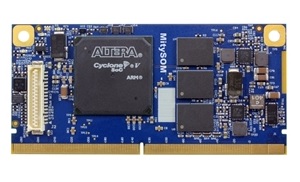It was the title of the article on EE Journal that caught my eye: “FPGAs Race for the Bottom,” which rounds up recent FPGA releases. Writer Kevin Morris claims this occur when the “bleary eyed marketing machines” who’ve been hyping technologies that are (perhaps) more exciting wake up and realize, “’Oh, yeah – we should do something about the FPGAs almost everybody actually USES as well.’ And then we start talking about ‘cost-optimized portfolios.’”
Morris then starts his roundup with a mention of a not-so-recent announcement from Xilinx, which in September unveiled a portfolio that included updates to their Spartan, Artix, and Zync families. (Xilinx is a long-term Critical Link partner. Our MityDSP-L138F uses a Spartan-6, as does the MitySOM-1808F.)
Next up, he talked about Intel’s additions to their Cyclone line. I still find myself a bit startled w hen I see Intel’s name in there, as I still think of their FPGA business as Altera, which was acquired by Intel a bit over a year ago. Like Xilinx, Altera is a partner, and the Cyclone V is part of our MitySOM-5CSx. The overall theme of the article is, as tends to happen with technology (think Moore’s Law), more bang for the buck. In the world of FPGA, speed is increasing, power consumption improving, and costs decreasing.
hen I see Intel’s name in there, as I still think of their FPGA business as Altera, which was acquired by Intel a bit over a year ago. Like Xilinx, Altera is a partner, and the Cyclone V is part of our MitySOM-5CSx. The overall theme of the article is, as tends to happen with technology (think Moore’s Law), more bang for the buck. In the world of FPGA, speed is increasing, power consumption improving, and costs decreasing.
On the performance front, Intel is claiming 300MHz core performance for the Cyclone 10 logic fabric, and they are including up to 384 DSP blocks with 18×19 multipliers and hardened floating point. Memory resources include up to 588 memory blocks with up to 11,760 Kbits of storage, plus up to 1,800 Kbits distributed RAM.
Pretty impressive stuff!
The final vendor covered in the article is Microsemi, which introduced their PolarFire FPGAs. Microsemi’s FPGA focus has historically been the “high-reliability military/aerospace market.” They’re now coming into the lower end market, and will be going toe-to-toe with Xilinx and Altera, I mean Intel.
PolarFire is a non-volatile, flash-based FPGA. That brings some nice advantages in the low-cost market, including removing the need for external configuration circuitry, improving security, reducing startup time, improving low-power standby mode, and reducing power consumption.
The article goes into a lot of detail on the different FPGAs, and is definitely worth a read. There’s also a pretty lively commenting section that you’ll want to look at while you’re there.
The bottom line is that, with these announcements, there’s a lot more on offer in the cost-optimized FPGA market. Which is especially exciting here at Critical Link, as we are sure to be working with most – if not all – of these devices on one project or another soon.
As Morris concludes,
It is, apparently, a great time to be designing with FPGAs.
Hey, it’s always been a great time to be designing with FPGAs.
